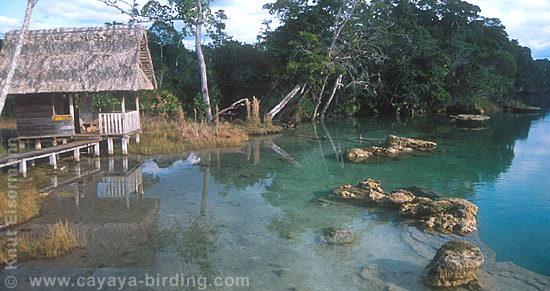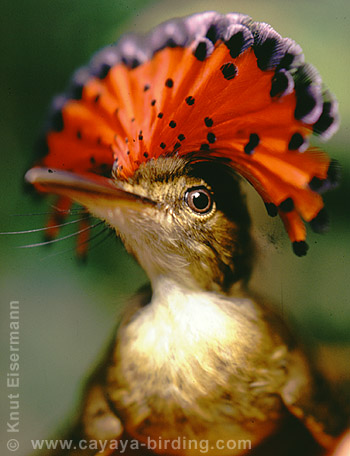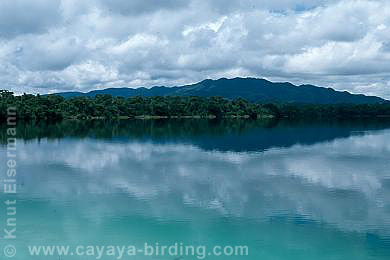Laguna Lachuá National Park
Laguna Lachuá National Park is a destination for birders who like to hike. The park is a 14,500 hectare large fragment of very humid lowland rainforest in an area with the highest annual rainfall in Guatemala. More than 310 bird species have been recorded. Like a "little piece of the Caribbean", the national park is famous for its lake with its brilliant turquoise-colored water.

Getting to the lake requires a 4.5 km walk through the rainforest. Mixed-species bird flocks include Black-throated Shrike-Tanager, Red-crowned and Red-throated Ant-Tanagers, Lesser Greenlet. Common hummingbirds are Rufous-tailed Hummingbird, White-bellied Emerald, Long-billed and Stripe-throated Hermit.
Laguna Lachuá National Park supports a large assemblage of rainforest hawks, including three hawk-eagles (Black, Ornate, and Black-and-white), Gray-headed Kite, Double-toothed Kite, and King Vulture. In the late afternoon a Bat Falcon often hunts for dragonflies along the lake shoreline. The most common owl is Mottled Owl, but also Crested and Spectacled Owl occur.
Most common Neartic-Neotropical migratory birds in the forest are Wood Thrush, Kentucky Warbler, Magnolia Warbler, and Black- and-white Warbler. Cerulean Warblers pass through in April.
How to get there and accommodation: Nowadays Laguna Lachuá National Park is easily accessible on a paved road from Cobán (approximately 4 hours). From park entrance a 4.5 km long well maintained foot-trail leads through the rainforest to the visitor center on the shore of Laguna Lachuá. The visitor's center has a simple lodge with two levels. It is just two minutes away from the lagoon and is equipped with bunk beds and clean sheets, mosquito nets and solar energy. Compost toilets of local standard are available.
When is the best time for a visit to Laguna Lachuá? Any time of year is well worth the trip, however the primary bird breeding season, and thus the highest bird activity, is from March to June.
How do you support conservation and development in Laguna Lachuá National Park? Your visit will help finance conservation and survey activities in and around the national park. Forest rangers patrol the primary forest in order to control illegal use and extraction of natural resources. Some of these rangers also participate in environmental education programs for children in the schools around the park and others attend primarily to tourism activities. In addition, these same rangers, as part of a collaboration with the state-run San Carlos University, have been trained to work as field assistants in scientific studies carried out by the university in the park. Another positive program you will be supporting is the park's effort to establish and maintain friendly relations with neighboring communities and their farmers. The park's administration has made a concerted effort to help neighboring farmers participate more in tourism activities in the area as an alternative income source to slash and burn farming. This program has been an important step in converting neighboring farmers into conservation agents and with the jobs that your tourism can help generate in these communities, you are helping to reduce the human impact on the park's biodiversity. Laguna Lachuá is part of the Lachuá-Ik'bolay Important Bird Area (IBA GT008).

